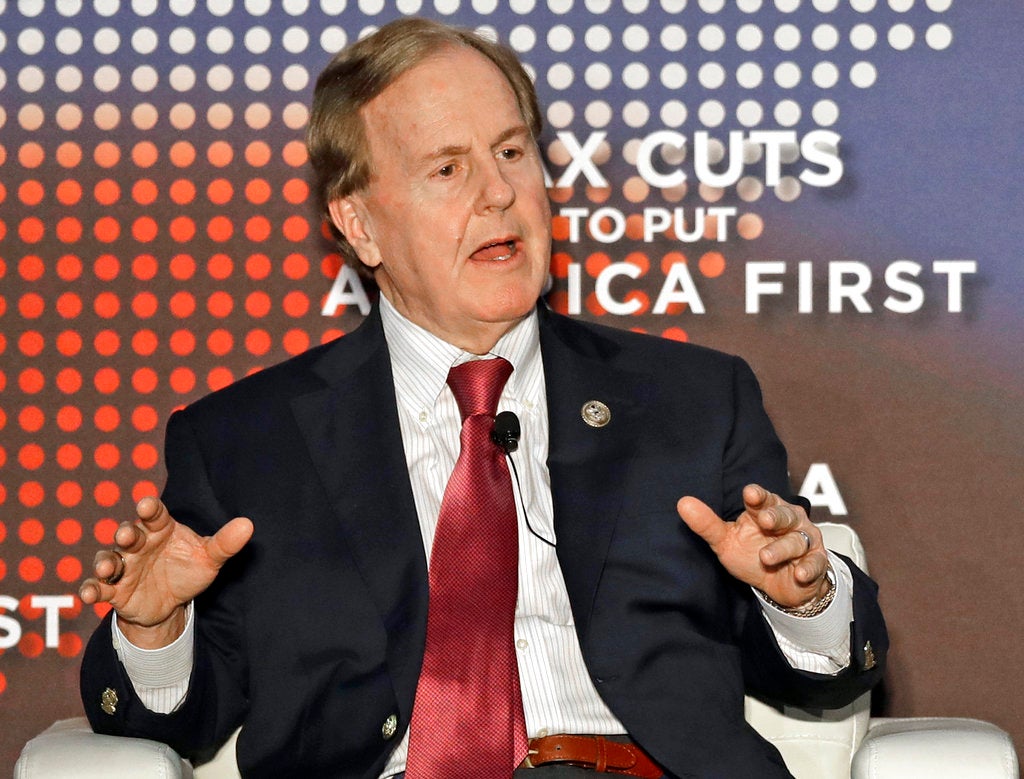Dr. Michael Bitzer: A sign of things to come? Parsing 9th & 13th District primary results
Published 12:00 am Thursday, May 10, 2018

- U.S. Rep. Robert Pittenger, R-North Carolina, speaks at an event on tax policy in Charlotte recently. Three-term incumbent Pittenger narrowly lost Tuesday, May 8, 2018, to a Southern Baptist pastor in a GOP primary rematch focused on their evangelical Christian credentials and loyalty to President Donald Trump. (AP Photo/Chuck Burton, File)
The 9th Congressional District Republican contest lived up to the belief that it would be another competitive rematch between incumbent Robert Pittenger and the Rev. Mark Harris. In 2016, when Pittenger secured the nomination with a 134-vote win over second-place finisher Harris, there was a viable third candidate whose base was in Union County, which he subsequently won. This year’s contest also had a third candidate, but one who only generated 1,862 total votes, so the match was definitely between Pittenger and Harris.
In the end, 814 votes determined 2018’s winner of the GOP contest, with Harris keeping Pittenger’s percentage in Mecklenburg County (both Harris’ and Pittenger’s home county) close to his 2016 numbers: Pittenger won Mecklenburg with 48 percent of the vote in 2016, and carried Mecklenburg with only 51 percent this time.
But the key difference was again Union County. While Pittenger improved substantially on his 27 percent in 2016 in the county to 43 percent, Harris went from 36 percent in 2016’s three-way contest in Union to 55 percent this year.
9th District turnout
The other major component to this race was the increased voter turnout. Granted, 2016’s primary was held in June after a court decision redrew the congressional district lines, and so the depressed voter turnout was to be expected. But the increase from 26,600 votes in 2016 to nearly 35,500 votes was due to the smaller counties in the district seeing significant jumps in voters casting ballots. While Mecklenburg saw a 6 percent increase and Union County saw a 28 percent increase, several other counties saw tremendous jumps: Bladen with 169 percent increase, Cumberland with a 106 percent increase, Richmond with 154 percent increase, Robeson with a 174 percent increase, and Scotland with a 102 percent increase.
Overall, 33 percent more voters participated in the GOP 9th District primary contest than did in 2016.
First incumbent to fall
As I’ve talked with reporters following the fall-out of the first Republican incumbent to Congress being denied renomination in this election cycle, the typical reasons for incumbents not regaining their party’s nomination are a significant scandal, loss of trust among the partisan base voters or being in their first term and seeking their first nomination. The “first re-election” bid reason is typically the most vulnerable for first-term officials.
It could also be due to the fact that the party’s base, so closely aligned to the Trump “outsider to D.C.” philosophy, may have played a role in this incumbent defeat.
The second observation, staying at the N.C. congressional level, is the strength of Democratic primary candidates who won, especially Dan McCready in the 9th Congressional District. While we don’t have a clear platform to assess the Democratic “wave” that many are expecting, it is notable that in the 9th, both Republican Pittenger and Harris had a lower combined vote total than did McCready, and that more voters in the 9th took the Democratic ballot than the Republican ballot.
Manning’s prowess
The other Democratic primary winner of the night was the 13th’s Kathy Manning, who secured 70 percent of her primary vote to face Republican incumbent and first-term Ted Budd. The 9th and the 13th are looking to be the marquee congressional races in the Old North State come this fall, due to the sense of ideal Democratic candidates for the district and their proven fundraising prowess so far.
The third observation to Tuesday’s primaries: the localized losses of state legislative incumbents. Two state Democratic incumbents and five state Republican incumbents to the NC General Assembly lost their renomination bids. The likelihood is that many of these defeats were very localized, but it is striking that incumbency was not as safe a bet as it has been in the past.
Powerful 15 percent
Finally, Tuesday’s voter turnout— or more realistically, the lack thereof. In 2014’s mid-term election, a statewide voter turnout rate was 15.79 percent, with a highly competitive Republican U.S. Senate nomination battle between Thom Tillis and Mark Harris, among others. This primary saw a voter turnout of 14.25 percent, which was around the “15-ish” percent that I had thought we would see.
Now, some would argue, hey, that’s pretty good considering that there wasn’t a state-wide race this primary and you almost matched 2014’s number.
Yes, but still: for many offices, this election was the final/general election because of the lack of an opposing candidate for the fall’s general election. So, 85 percent of North Carolina’s 6.9 million voters stayed home, went to work and did something other than cast their voice and vote in determining who would represent them. In other words, the voice and vote of the 15 percent who did show up was a lot louder and more powerful.
Dr. Michael Bitzer is director of the Center for Engaged Learning and Teaching at Catawba College. This article is from his blog, Old North State Politics. Read more at http://www.oldnorthstatepolitics.com/.

